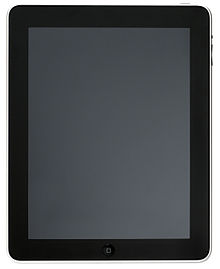- Cockpit iPads
-
Cockpit iPads are the latest idea that is becoming popular in the aviation world, which replaces paper charts and manuals with the Apple iPad. This Technology is currently being used by both private and commercial aircraft pilots and hopes to revolutionize the way pilots conduct their flying as well as make it easier and safer for the pilots in the industry.
Contents
History and testing
The iPad has been used in General Aviation for the last year in conjunction with its paper backup counterpart, which is mandated by the Federal Aviation Administration. Applications such as Jeppesen Mobile TC and ForeFlight Mobile were the first applications made available to consumers for the iPad. These applications include everything that would be on the paper charts plus aviation tools including navigation charts, taxi procedures, weather maps, GPS, Minimum Equipment List, Company Policy Manuel, Federal Aviation Regulations and flight controls. Although these tools have been used in the private sector, the use of the iPad in commercial aviation is just taking flight. The Federal Aviation Administration has just finished a three-month testing project which included putting the device thru adverse conditions such as rapid decompression testing and tests to make sure the tablet did not interfere with the avionic equipment. The test concluded with awarding the new technology to the charter company Executive Jet Management and allows them to be used without the backup paper charts.[1] This award helps make way for the iPad to become an aviation instrument for the rest of the industry. Airlines currently testing or in the process to begin testing include Alaskan Airlines,[2] Delta Air Lines,[3] and American Airlines.[4]
Practicality
The main push to use the iPad as a navigation tool is the practicality of the product. The iPad would replace about 25 pounds of paper charts used by pilots that include flight manuals, approach plates, navigation charts, policy manuals, minimum equipment list and taxi charts.[5] Major airlines based in the United States are mainly paper based, which includes some who have fleets of 900 plus planes. This translates to a lot of paper in the form of charts that could be saved by the iPad. The switch to an electronic system would also make life easier on the pilot. No longer would pilots carry around a heavy flight bag. Instead it would be replaced by the 9.5 inch by 7.31 inch 1.33 pound tablet. Flight planning is also made easier by the iPad. To prepare for the flight the pilot would be able to use one device to check everything from weather, other airport facilities and flight plans. All this makes a pilot's life a lot easier.
Safety
The main thing the iPad does is decrease clutter in the cockpit. This leads to a safer flight for the pilot and passengers. Charts would no longer be needed and would eliminate the pilots need to spread the large charts out in the small cockpit. This helps the pilot spend more time flying and prevents the charts from sometimes obstructing their view. Pilots can quickly swipe their fingers around the chart as well as switch charts in matter of seconds. This give pilots more time look out the cockpit window and allows them to be able to just take a glance instead of searching around on a map. A number of issues have been brought up including distractions in the cockpit, but the Internet on the iPad could not be used at those altitudes and pilots would still be using onboard GPS instruments.[6] Other safety issues include software failure and power outage, but in the three-month test Executive Jet Management conducted, not once did the application shut off or have a failure. Tests did show that if a failure did take place the program could reboot in four to six seconds. Extra iPads in the cockpit are also being talked about as a backup to a system failure.[7] Airlines are also looking into the safety of the placement of the iPads in the cockpit. The most popular placement is a strap that connects to the pilot's upper thigh and makes the device hands free, but many commercial airlines are looking into a dock that is connected to the plane itself.[8]
References
- ^ Paur, Jason. "FAA Approves iPads for pilots' electronic charts". CNN. http://edition.cnn.com/2011/TECH/innovation/02/28/FAA.approves.iPads/index.html. Retrieved 3/12/11.
- ^ Roberto. "Delta Air Lines, Alaska Airlines Testing iPad as "In-Cockpit" Flight Tool". Pad Gadget. http://www.padgadget.com/2011/03/07/delta-air-lines-alaska-airlines-testing-ipad-as-in-cockpit-flight-tool/. Retrieved 12 March 2011.
- ^ Roberto. "Delta Air Lines, Alaska Airlines Testing iPad as "In-Cockpit" Flight Tool". Pad Gadget. http://www.padgadget.com/2011/03/07/delta-air-lines-alaska-airlines-testing-ipad-as-in-cockpit-flight-tool/. Retrieved 12 March 2011.
- ^ Cormier, Jeff. "Apple iPad 2 may soon replace paper charts in airline cockpits". The iPad Fan. http://www.theipadfan.com/apple-ipad-2-replace-paper-charts-airline-cockpits/. Retrieved 12 March 2011.
- ^ Paur, Jason. "FAA Approves iPads for pilots' electronic charts". CNN. http://edition.cnn.com/2011/TECH/innovation/02/28/FAA.approves.iPads/index.html. Retrieved 3/12/11.
- ^ Business Staff. "Alaska Airlines testing iPads in cockpits". The Seattle Times. http://seattletimes.nwsource.com/html/sundaybuzz/2014402413_sundaybuzz06.html. Retrieved 12 March 2011.
- ^ Paur, Jason. "FAA Approves iPads for pilots' electronic charts". CNN. http://edition.cnn.com/2011/TECH/innovation/02/28/FAA.approves.iPads/index.html. Retrieved 3/12/11.
- ^ Business Staff. "Alaska Airlines testing iPads in cockpits". The Seattle Times. http://seattletimes.nwsource.com/html/sundaybuzz/2014402413_sundaybuzz06.html. Retrieved 12 March 2011.
External links
Categories:
Wikimedia Foundation. 2010.


